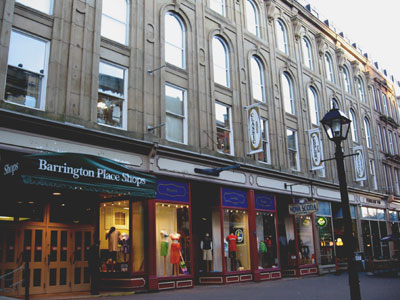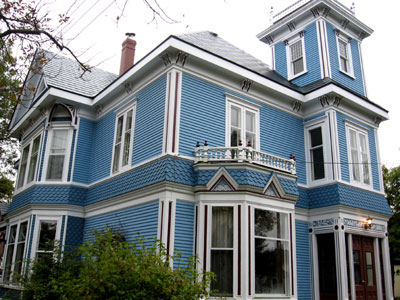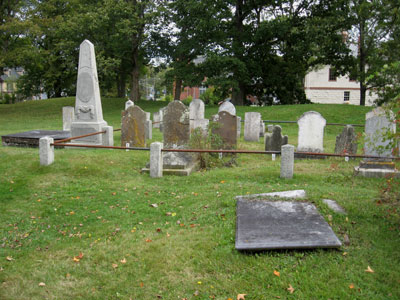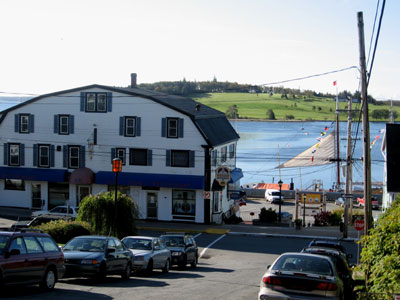The kitchen next door was a place where geese, rabbits and other interesting dishes would be prepared and fresh bread would be baked. The adjacent Common Room was decked out in 17th century style with pewter tableware and was the location of frequent dinners of the French settlers and Mi’kmaq natives. The “Order of Good Cheer” was the first European social club, founded to while away the long dark winter nights. Prominent members of the colony took turns preparing a feast, arranging entertainment and preparing delicacies such as fricasseed beaver tail and boiled moose nose.
Despite the harsh conditions at the early settlement, culture was present at Port-Royal. A Parisian lawyer by the name of Marc Lescarbot, spent the winter of 1606-1607 at the Habitation and wrote a play called “The Theatre of Neptune” which was first performed in November of 1606. He also chronicled life in the habitation and his records provide great insight into the daily challenges of early French settlers.

The craftsmen’s sleeping quarters
Wayne then introduced me to the second-story dormitory that at the time would have held about 30 craftsmen, including joiners, carpenters, masons, stonecutters, locksmiths and iron workers. These men were required to work three hours a day at their trade and could use the rest of their time to go fishing, hunting or tend their gardens. A foot-powered spring pole lathe was made to turn wood and create objects such as spindles, goblets and candlesticks. Wayne gave me a demonstration of this contraption and the functionality of this human-powered piece of equipment was astounding.

The foot-powered lathe
The apothecary next door was in charge of ensuring the health of the early settlers. Various herbs would be crushed with a pestle and mortar to provide remedies for common health problems. This was a harsh environment and many of the original inhabitants did not survive the harsh winters.

The apothecary
Several gentlemen’s quarters follow, each equipped with bunk beds and draw curtains for privacy. Generally each room was inhabited by two to four gentlemen and equipped with a table, chair, wardrobe, a large bench and a fireplace. The largest sleeping quarters are those of the Governor which are decorated with a smoked moose hide, artwork originally produced by the Mi’kmaq natives which was much admired by the French settlers. Wayne explained that moose hide would often be worn to protect against the cold. The most effective way was to wear the hairy side on the inside with the smooth part facing outside.

Wayne introduces the decorative moose hide
The next building holds the fur storage area where furs from various animals are displayed, including beaver, silver fox, bobcat, raccoon, timber wolf, otter and lynx furs. Wayne informed me that beaver fur was the most valuable fur since there was a big craze for beaver fur hats at the European royal courts. Essentially the entire early settlement of Canada was a result of Europe’s fashion hunger for beaver fur. Rabbit fur was also used to make hats, but in order to remove the keratin from the hair, mercury had to be used which had severe effects on the mental health of the craftsmen producing the hats. Wayne explained that this is where the expression “mad as a hatter” comes from.

Fur Storage Room featuring different types of fur
When we entered the wine cellar, my expert guide pointed out that every man who resided here received 1.5 pints (about 1 litre) of wine a day. Wine was considered much healthier since much of the water in the early communities was polluted due to poor sanitary conditions. People would toss their slob buckets into the rivers, effectively contaminating their own drinking water supply.

The wooden palisades enclosing the Cannon Platform
Next door we entered the trading room which was a room were barter transactions for basic goods would take place. In a loft upstairs a Mi’kmaq canoe as well as an original coffin is on display. The steep roof would help the snow slide off during the long harsh winters. Wayne then took me outside to the Cannon Platform from where there is a great view over the Annapolis River. Any intruder approaching the area could easily be seen from this platform.

Outside view of the Habitation
Outside the Habitation is a monument honouring Membertou, one of the great Mi’kmaq chiefs who helped the French adapt and survive in Acadia who together with his family was baptized in 1610. I thanked Wayne Melanson for his great introduction to Port-Royal, this early place of French history. On an increasingly cloudy day I made my way back to Annapolis Royal, stopping to take some pictures of a few beautiful house in Granville Ferry, the town located directly across from Annapolis Royal. Prior to an earlier bridge and today’s causeway, Granville Ferry was indeed the location of a ferry service that would connect both towns by ship.

A stately mansion in Granville Ferry
Shortly after I arrived back in Annapolis Royal and was more than ready for a tasty dinner. And I would have a chance to see history brought to life in my much anticipated Garrison Graveyard Tour, to be presented by Alan Melanson, the other member of this duo of historic experts.




